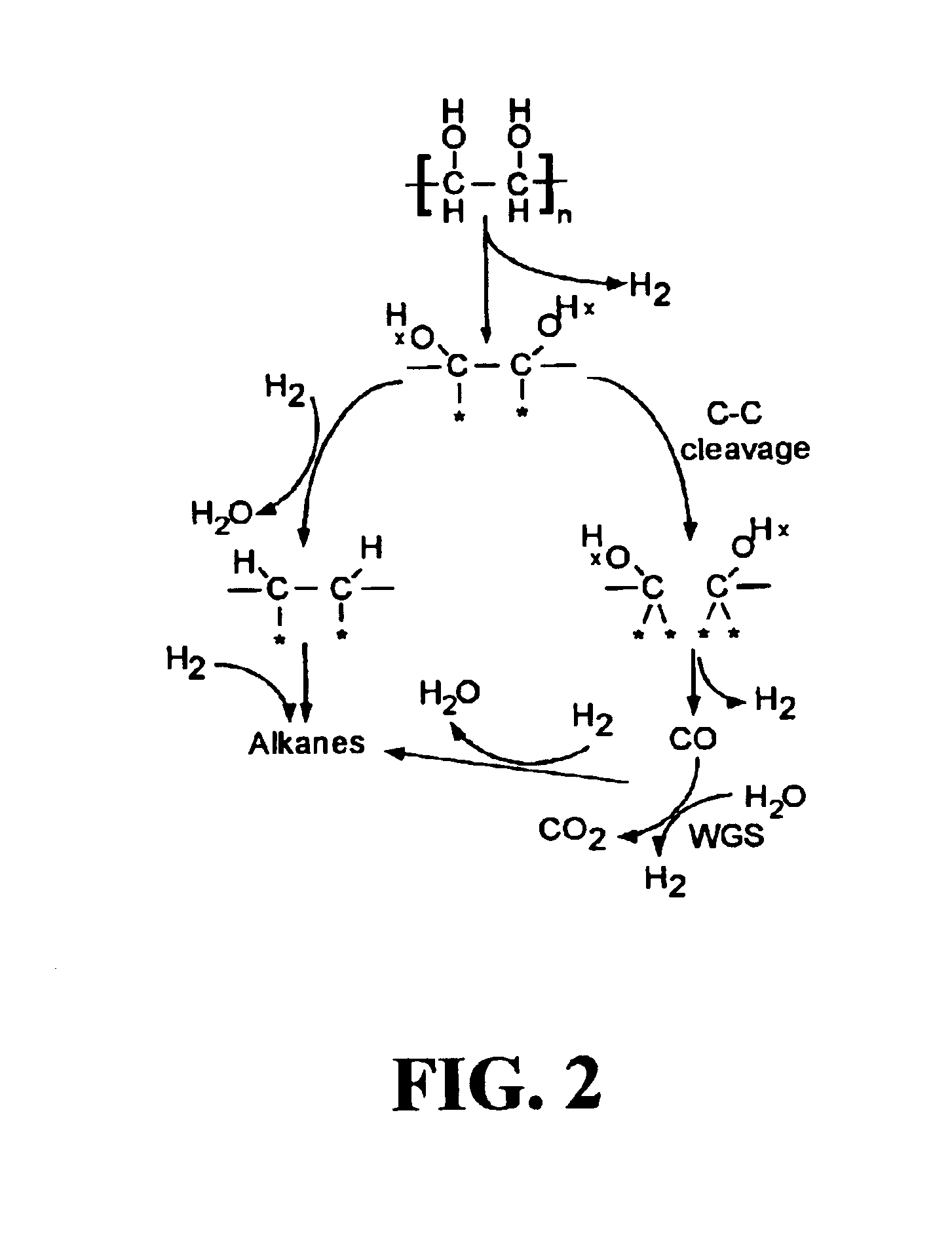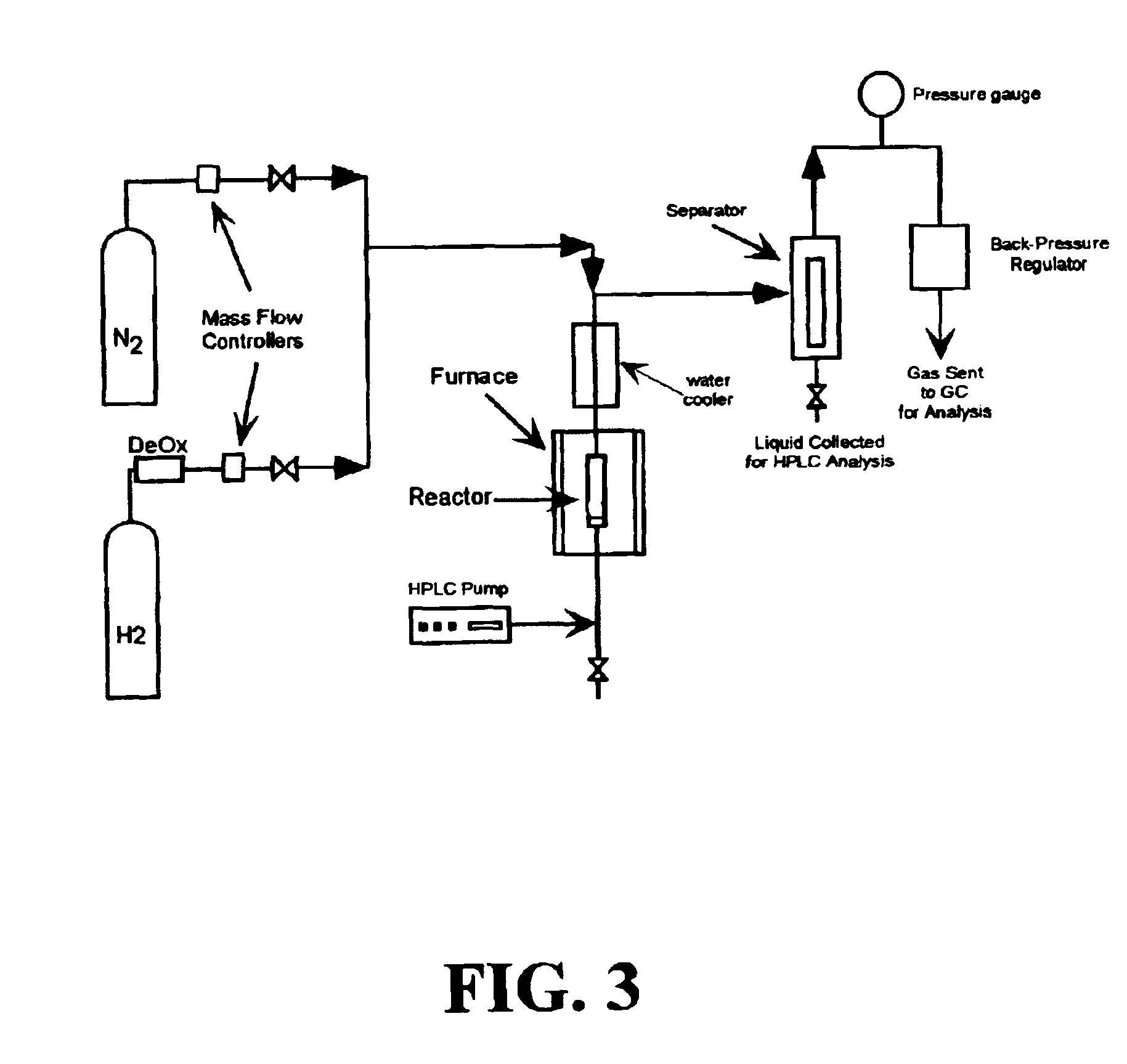Low-temperature hydrocarbon production from oxygenated hydrocarbons
- Summary
- Abstract
- Description
- Claims
- Application Information
AI Technical Summary
Benefits of technology
Problems solved by technology
Method used
Image
Examples
example 1
[0080]A 5 wt % silica-supported platinum catalyst system (Pt / SiO2) was prepared through the exchange of Pt(NH3)42+ with H+ on the silica surface. The preparation procedure involved the following steps: (1) Cab-O-Sil EH-5 was exchanged with an aqueous Pt(NH3)4(NO3)2 solution (Aldrich Chemical, Milwaukee, Wis.) with the degree of exchange controlled by adjusting the pH of the silica slurry with an aqueous, basic solution of Pt(NH3)4(OH)2; (2) the resulting material was filtered and washed with deionized water; and (3) and the filtered material was dried overnight in air at 390 K.
example 2
[0081]A 5 wt % silica-supported platinum catalyst system was made according to the procedure described in Example 1. The catalyst was, however, modified by dehydroxylation and capping with trimethylethoxysilane. The catalyst system was prepared as follows: (1) fumed silica (Cab-O-Sil, EH-5 grade) was dried at 600 K for 10 hours under flowing helium; (2) platinum was added to the support by vapor-phase deposition of Pt(II) acetylacetonate at 500 K; (3) the resulting Pt / SiO2 catalyst system was calcined at 600 K in flowing oxygen; (4) the calcined catalyst system was reduced at 600 K with flowing hydrogen; (5) the resulting catalyst system was dehydroxylated under flowing helium at 1173 K; (6) the catalyst system was treated with CO at 300 K to prevent the platinum sites from reacting with trimethylethoxysilane; (7) the resulting catalyst was dosed with 4.5 mmol trimethylethoxysilane (Gelest, Inc., Tullytown, Pa.) at 300 K; (8) the catalyst was dosed with CO until the residual pressur...
example 3
[0082]Liquid phase reforming of sorbitol was performed using the metallic catalyst systems described in Examples 1 and 2. The apparatus used for the reforming is the apparatus depicted schematically in FIG. 3. The catalyst was loaded into a ¼ inch stainless steel reactor. The catalyst was reduced by flowing hydrogen across the catalyst at a temperature of 225° C. After reduction, the reactor was cooled. The system was then purged with nitrogen, and a HPLC pump was used to fill the reactor with a 10 wt % sorbitol aqueous solution. Once liquid was observed in the separator, the pressure of the system was increased to 21.7 bar with nitrogen (the pressure is controlled by the backpressure regulator 26; see FIG. 3). While the liquid feed was pumped over the catalyst bed, the furnace heated the bed to 225° C. The liquid exited the reactor and was cooled in a double-pipe water cooler (FIG. 3, reference number 22). The fluid from this cooler was combined with the nitrogen flow at the top of...
PUM
 Login to View More
Login to View More Abstract
Description
Claims
Application Information
 Login to View More
Login to View More - R&D
- Intellectual Property
- Life Sciences
- Materials
- Tech Scout
- Unparalleled Data Quality
- Higher Quality Content
- 60% Fewer Hallucinations
Browse by: Latest US Patents, China's latest patents, Technical Efficacy Thesaurus, Application Domain, Technology Topic, Popular Technical Reports.
© 2025 PatSnap. All rights reserved.Legal|Privacy policy|Modern Slavery Act Transparency Statement|Sitemap|About US| Contact US: help@patsnap.com



